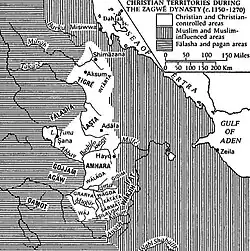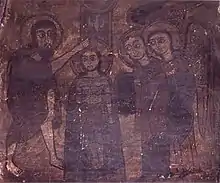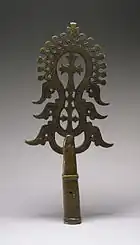Zagwe dynasty | |||||||||
|---|---|---|---|---|---|---|---|---|---|
| 1137–1270 | |||||||||
 Christian territories during the Zagwe Dynasty circa 1200 AD | |||||||||
| Capital | Lalibela[1] | ||||||||
| Common languages | |||||||||
| Religion | Ethiopian Orthodox Tewahedo (official)[5] | ||||||||
| Demonym(s) | Ethiopian Abyssinian | ||||||||
| Government | Monarchy | ||||||||
| King | |||||||||
• early 12th century | Mara Takla Haymanot | ||||||||
• 13th century | Yetbarak | ||||||||
| History | |||||||||
• Established | 1137 | ||||||||
• Other theories for the start | c. 930 | ||||||||
| 1270 | |||||||||
| |||||||||
| History of Ethiopia |
|---|
 |
The Zagwe dynasty (Amharic: ዛጔ መንግሥት) was a medieval Agaw Orthodox Christian monarchy that ruled the northern parts of Ethiopia and Eritrea. The Agaw are a Cushitic ethnic group native to the northern highlands of Ethiopia and neighboring Eritrea.[6] Centered at Roha (later named Lalibela), it ruled large parts of the territory from approximately 900 to 1270 AD, when the last Zagwe King Za-Ilmaknun was killed in battle by the forces of the Amhara King Yekuno Amlak. The Zagwe are most famous for their king Gebre Mesqel Lalibela, who is credited with having constructed the rock-hewn monolithic churches of Lalibela.
The name "Zagwe" is thought to derive from the ancient Ge'ez phrase Ze-Agaw, meaning "of the Agaw", in reference to the Mara Tekle Haymanot, the founder of the dynasty.[7] This term does not appear in contemporary sources, neither in indigenous documents nor in accounts of foreign observers.[8]
David Buxton has stated that the areas under the direct rule of the Zagwe kings apart from the centre of power in Lasta "probably embraced the highlands of modern Eritrea, Tigray, Wag and Bete Amhara and thence westwards towards Lake Tana (Begemder)."[9] Unlike the practice of later rulers of Ethiopia, Taddesse Tamrat argues that under the Zagwe dynasty the order of succession was that of brother succeeding brother as king, based on the Agaw laws of inheritance.
History
According to one tradition, around 960, Queen Gudit destroyed the remnants of the Kingdom of Aksum, causing a shift in its temporal power centre that later regrouped more to the south. For 40 years she ruled over what remained of the kingdom, eventually passing on the throne to her descendants, with Mara marrying the daughter of the last king of Aksum, Dil Na'od. According to other Ethiopian traditional accounts, the last of her dynasty was overthrown by Mara Takla Haymanot in 1137.[10] Still more, according to another tradition, Mara was born in the province of Lasta, which was his power base. Originally a general of Dil Na'od, whose daughter Masoba Warq became his wife, Mara overthrew his father-in-law to found the new dynasty.[10] James Bruce, on the other hand, presents another tradition that Dil Na'od was overthrown by Gudit, and that Mara Takla Haymanot (whom Bruce calls "Takla Haymanot") was a cousin of Gudit who succeeded her after several of her own family.[11]
%252C_de_best_bewaard_gebleven_kerk_(6821637099).jpg.webp)
Three inscriptions discovered in Axum mention the names of two kings, Dabra Ferem and his son Hasani Dan'el, who were Christian but are not recorded on Ethiopian regnal lists.[12] The first inscription tells how Hasani Dan'el attacked rebel tribes in Kassala and claims that he conquered thirty peoples.[12] The second inscription tells how the people of Welkait rebelled and laid waste to Axum, and in response he carried off large numbers of cattle and other animals from them.[12] Dan'el then went to the country of the Maya and took 10,000 sheep and 3,000 cattle.[13] The third inscription tells of how Dan'el went to Axum after his campaigns to be acknowledged as king and imprisoned the old king.[13] It is difficult to date the reigns of these kings, but it likely occurred in the early 10th century when the power of the Solomonic line was in decline.[14] Enno Littmann theorized that these kings were forerunners of the Zagwe dynasty and E.A. Wallis Budge believed they may have even founded the Zagwe line.[13]

The Zagwe period is still shrouded in mystery; even the number of kings in this dynasty is disputed. Some sources (such as the Paris Chronicle, and manuscripts Bruce 88, 91, and 93) give the names of eleven kings who ruled for 354 years; others (among them the book Pedro Páez and Manuel de Almeida saw at Axum) list only five who ruled 143.[15] Paul B. Henze reports the existence of at least one list containing 16 names.[16]
According to Carlo Conti Rossini, the shorter mooted length of this dynasty is the more likely one. He argues that a letter received by the Patriarch of Alexandria John V shortly before 1150 from an unnamed Ethiopian monarch, in which the Patriarch is asked for a new abuna because the current office holder was too old, was from Mara Takla Haymanot, who wanted the abuna replaced because he would not endorse the new dynasty.[18]
The mystery of the Zagwe dynasty is perhaps darkest around its replacement by the Solomonic dynasty under Yekuno Amlak. The name of the last Zagwe king is lost—the surviving chronicles and oral traditions give his name as Za-Ilmaknun, which is clearly a pseudonym (Taddesse Tamrat translates it as "The Unknown, the hidden one"), employed soon after his reign by the victorious Solomonic rulers in an act of damnatio memoriae. Taddesse Tamrat believes that this last ruler was actually Yetbarak. The end of the Zagwe came when Yekuno Amlak, who never personally claimed to be descendant of Dil Na'od or King Solomon, and acting under the guidance of either Saint Tekle Haymanot or Saint Iyasus Mo'a, pursued the last king of the Zagwe and killed him at the Battle of Ansata.[19]
Royal title

In his land grants of 1204 and 1225, Lalibela called himself negus ("king"), which was the traditional title for Ethiopian kings. Besides negus he also called himself hasani, which means as much as "tutor", "nurse" or "counselor". This title first appeared in an 10th-century account by Ibn Hawqal describing an anonymous Ethiopian king, but also features in two undated Ge'ez inscriptions and the 12th-century land grant of king Tantawedem. Lalibela's land grants are the last time hasani is associated with the king. By the reign of Amda Seyon in the first half of the 14th century it was used to denote a provincial governor.[20]
Like the kings of Aksum who preceded them, the Zagwe kings bore three names: a baptismal name, a regnal name and finally the surname.[21]
Foreign relations

.jpg.webp)
Unlike Aksum, the Zagwe were virtually unknown to the contemporary powers of the Mediterranean. The only regular relations seem to have been maintained with Egypt and Jerusalem.[23] Although their presence is often claimed to have been of considerable antiquity, it is only in the 11th and 12th centuries when Ethiopians are firmly attested to have lived in Egypt.[24] A rare testament for their presence during the reign of the Zagwe is a fragmentary manuscript written in Ge'ez that was recently discovered in the Monastery of Saint Anthony, dating to the mid-12th to mid-13th centuries.[24]
The earliest sources confirming an Ethiopian community in Jerusalem date to the second half of the 13th century.[25] Yet it is still probable that Ethiopians had lived there before. In the late 12th century, King Lalibela's knowledge of the town was sufficient enough to have inspired him during the expansion of his capital, adopting Jerusalem's form, attributions and toponyms.[26]
Islam

According to Muslim tradition, Muhammad and his companions briefly lived in Ethiopia in 622 after being exiled from Mecca in the First Hijra, although there is no archaeological evidence for this.[27] There is, however, evidence for a Muslim community[lower-alpha 1] in eastern Tigray during the Zagwe period, possibly being Shiites depending on Fatimid patronage.[28] Arabic funerary stelae discovered near Qwiha confirm the presence of an Islamic settlement between the 10th and 12th century, although its whereabouts are still unclear.[27] Recent excavations at nearby Bilet found a Muslim cemetery that was in use from the late 10th to the mid-13th century, although most tombstones date to the 11th century. The nisbas of the deceased suggest links with Egypt, the Arabian peninsula and even Iran. Another Islamic cemetery was found at Arra 30 km southwards and was used between the mid-12th and mid-14th century, with most tombstones dating to the 13th century.[30] A now broken frieze with a Kufic inscription stored in the Wukro Chirkos church probably dates to the second half of the 11th century and may have originally been from a mosque, perhaps sponsored by the Fatimids.[31] Tigray's Muslim community declined from the 12th century because of the collapse of the Fatimids and, if the land grant by king Tantawedem is to be believed, its dispossession by the Zagwe.[32]
See also
Notes
- ↑ It has been proposed that they were under influence of the Dahlak Sultanate.[28] The much later hagiography of St. Marqorewos, who lived around the year 1400, mentions a Muslim king in nearby Shire who might have lived during the reign of king Lalibela.[29]
References
- ↑ Tekeste Negash (March 2006). "The Zagwe Period and the Zenith of Urban Culture in Ethiopia, c. 930–1270 AD". Africa: Rivista trimestrale di studi e documentazione dell'Istituto italiano per l'Africa e l'Oriente. 61 (1): 120–137. JSTOR 40761842.
- ↑ Mohammad Hassan, The Oromo of Ethiopia, p. 3
- ↑ Demeke, Girma A. (2014). The Origin of Amharic. The Red Sea Press. p. 53. ISBN 978-1-56902-379-2. OCLC 824502290.
- ↑ Edward Ullendorff, The Ethiopians, Oxford University Press, 1960
- ↑ Falola, Toyin (2002). Key Events in African History: A Reference Guide. Greenwood Publishing Group. p. xv. ISBN 978-0313313233.
- ↑ Concise Encyclopedia of Languages of the World. Elsevier. 2010-04-06. ISBN 9780080877754. Retrieved 2023-10-25.
- ↑ Oliver, Roland (1982). The Cambridge history of Africa: From c. 1600 to c. 1790. Vol. 1. Cambridge University Press. p. 112.
- ↑ Marie Laure Derat (2020): "Before the Solomonids: Crisis, Renaissance and the Emergence of the Zagwe Dynasty (Seventh–Thirteenth Centuries)" in A Companion to Medieval Ethiopia and Eritrea. Brill. p. 47
- ↑ Buxton, David (1970). The Abyssinians. New York: Praeger. p. 44. ISBN 0-500-02070-1.
- 1 2 Taddesse Tamrat (1972). Church and State in Ethiopia. Oxford: Clarendon Press. pp. 53–64. ISBN 0-19-821671-8.
- ↑ Bruce, Travels to Discover the Source of the Nile (1805 edition), vol. 2 pp. 451–453
- 1 2 3 Budge, E. A. Wallis (1928). A History of Ethiopia: Nubia and Abyssinia (Volume I). London: Methuen & Co. p. 276.
- 1 2 3 Budge, E. A. Wallis (1928). A History of Ethiopia: Nubia and Abyssinia (Volume I). London: Methuen & Co. p. 277.
- ↑ Budge, E. A. Wallis (1928). A History of Ethiopia: Nubia and Abyssinia (Volume I). London: Methuen & Co. pp. 276–277.
- ↑ Huntingford, G. W. B. (1965). "'The Wealth of Kings' and the End of the Zāguē Dynasty". Bulletin of the School of Oriental and African Studies. 28 (1): 8. doi:10.1017/S0041977X00056731. JSTOR 611706. S2CID 161195803.
- ↑ Henze, Paul (2000). Layers of Time. New York: Palgave. p. 50 n.19.
- ↑ Chojnacki, Stanislaw (2005). "Wandgemäldem Ikonen, Manuskripte, Kreuze und anderes liturgisches Gerät". In Walter Raunig (ed.). Das christliche Äthiopien. Geschichte - Architektur - Kunst. Schnell & Steiner. pp. 236–237.
- ↑ Taddesse Tamrat (1972). Church and State in Ethiopia. Oxford: Clarendon Press. pp. 56ff. ISBN 0-19-821671-8.
- ↑ Huntingford 1965, p. 2
- ↑ Marie Laure Derat (2020): "Before the Solomonids: Crisis, Renaissance and the Emergence of the Zagwe Dynasty (Seventh–Thirteenth Centuries)" in "A Companion to Medieval Ethiopia and Eritrea". Brill. pp. 38–39
- ↑ Marie-Laure Derat (2010): "The Zagwe dynasty (11–13th centuries) and King Yemrehanna Krestos", Annales d'Ethiopie, 25, p. 171
- ↑ Flood, Finbarr Barry; Fricke, Beate (2023). Tales Things Tell: Material Histories of Early Globalisms. Princeton University. p. 179.
- ↑ Bausi, Alessandro (2017). "The Zagwe" in Ethiopia: History, Culture and Challenges, p. 108
- 1 2 El-Antony, Fr. Maximous; Blid, Jesper (2016). "An Early Ethiopic Manuscript Fragment (Twelfth–Thirteenth Century) from the Monastery of St Antony (Egypt)", Aethiopica, 19, pp. 47–48
- ↑ van Donzel, E. (1999). "Were there Ethiopians in Jerusalem at the Time of Saladin's Conquest in 1187?". East and West in the Crusader States: Context-Contacts-Confrontations II. Leuven: Peeters. ISBN 90-429-1287-1.
- ↑ Phillipson, David W. (2018). "Jerusalem and the Ethiopian Church. The Evidence of Roha (Lalibela)". Tomb and Temple: Re-imagining the Sacred Buildings of Jerusalem. Woodbridge: Boydell Press. pp. 261–266. ISBN 978-1-78327-280-8.
- 1 2 Loiseau, Julien et al. (2021): "Bilet and the wider world: new insights into the archaeology of Islam in Tigray" Antiquity 95, 509
- 1 2 Muehlbauer, Mikael (2021): "From Stone to Dust: The Life of the Kufic-Inscribed Frieze of Wuqro Cherqos in Tigray, Ethiopia" Muqarnas 38, 10
- ↑ Derat, Marie-Laure (2020): "L’affaire des mosquées. Interactions entre le vizirat fatimide, le patriarcat d’Alexandrie et les royaumes chrétiens d’Éthiopie et de Nubie à la fin du xie siècle" Médiévales 79, 27-28
- ↑ Loiseau, Julien et al. (2021): "Bilet and the wider world: new insights into the archaeology of Islam in Tigray" Antiquity 95, 523-525
- ↑ Muehlbauer, Mikael (2021): "From Stone to Dust: The Life of the Kufic-Inscribed Frieze of Wuqro Cherqos in Tigray, Ethiopia" Muqarnas 38, 15
- ↑ Muehlbauer, Mikael (2021): "From Stone to Dust: The Life of the Kufic-Inscribed Frieze of Wuqro Cherqos in Tigray, Ethiopia" Muqarnas 38, 17
Further reading
- Derat, M.-L. (2018). L'énigme d'une dynastie sainte et usurpatrice dans le royaume chrétien d'Ethiopie, XIe–XIIIe siècle (in French). Brepolis. ISBN 978-2-503-57908-5.
- Muehlbauer, Mikael (2023). "An African "Constantine" in the Twelfth Century: The Architecture of the Early Zagwe Dynasty and Egyptian Episcopal Authority". Gesta. 62 (2): 127–152.
